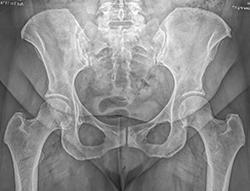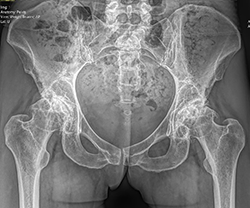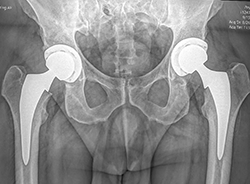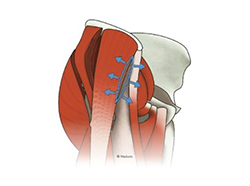Questions Related to the Hip
What is Hip Arthritis, symptoms & treatment?
Arthritis is a general term meaning joint inflammation. It is a specific type of wear and tear on the joints that affects nearly 21 million Americans. As we age, the chance of developing osteoarthritis increases and is the most common type of arthritis.
Osteoarthritis breaks down the cartilage in joints and can occur in almost any joint in the body. It is most common in the hips, knees, and spine. Cartilage is the rubbery material on the end of the bones that acts as a shock absorber and provides a smooth, gliding surface.
Over time, the cartilage may break down and wear away. This can lead to the bones rubbing together which causes pain, restricts motion of the joint and can be very uncomfortable during many daily activities.
What Does Arthritis Look Like?
Normal Hips

There is good space between the ball & socket joint and smooth bony surfaces at the joint which represents healthy cartilage and bone.
Severe Arthritis of Both Hips

These hips are bone-on-bone with complete loss of cartilage and joint space with jagged bone spurs on the ball and socket.
What are the Symptoms of Osteoarthritis?
- Joints that are sore and achy, especially after activity
- Pain after overuse or when joints are inactive for long periods of time
- Joint swelling
- Joint stiffness
What are the Causes of Osteoarthritis?
There are several factors that lead to developing osteoarthritis including family history, obesity, previous fractures involving a joint, prior surgery on a joint and overuse.
What Treatment Options are Available to Alleviate Hip Arthritis Pain?
- Live with the symptoms.
- Lifestyle modifications including weight loss and avoiding painful activities.
- Physical therapy
- Gait modification tools such a brace, cane, walker, special shoes or shoe inserts.
- Medications including NSAIDs - ibuprofen, Advil, naproxen, Aleve, Celebrex, meloxicam, Mobic or Tylenol.
- Anti-inflammatory diet or supplements such as glucosamine and turmeric.
- Injections such as cortisone (a steroid) or PRP (platelet rich plasma) into the hip joint.
- Total hip replacement to remove damaged cartilage and bone to improve pain and function.
What is a Hip Replacement?
Your hip is made of two basic parts that work together, creating a smooth motion. When arthritis develops, the cartilage becomes damaged and wears away, eventually requiring replacement. Total hip replacement surgery involves replacing the ball and socket with an artificial joint made of metal, ceramic, and plastic. The materials used are well-made and designed to last a very long time inside your body. Your orthopedic surgeon will take under consideration many factors including age, bone quality and the shape of your joints to determine the kind of hip replacement which is best for you.
Total Hip Replacement

Hip replacement surgery requires your surgeon to remove the damaged ends of the two bones and insert new artificial surfaces. Your orthopedic surgeon will resurface the hip socket of your pelvis with a metal shell and plastic liner. The upper part of your thigh bone (femur) will be fitted with a metal stem and ceramic ball that fits on the top of the stem. The new ball will glide and move within the newly lined hip socket.
What are the benefits of the Direct Anterior Approach?

The direct anterior approach is a surgical technique that is used to access the hip joint through the front of the hip. With this approach, your surgeon does not need to cut or detach muscle from the pelvis or femur during the procedure. This allows for quicker healing time, less pain and immediate stability of your new joint. Directly following an anterior approach hip replacement, patients are allowed to bend their hip freely and walk on the new hip right away.
The AMIS or Anterior Minimally Invasive Surgical technique (Direct Anterior Approach) used by Dr. Loucks has many potential benefits including:
- No muscles or tendons cut.
- Significantly shortened rehabilitation and faster return to daily activities.
- Decreased post-operative pain.
- Less blood loss and smaller scars.
- Reduced risk of dislocation.
- Specialized operating room table allowing x-ray guidance via anterior approach.
What are the Risks of having a hip replacement?
Hip replacement surgery is major surgery, and although advances in technology and medical care have made the procedure very safe and effective, there are risks. These risks should be carefully considered before you decide to have surgery. We encourage you to discuss the potential risks with your surgeon, primary care physician and your family.
Every measure will be taken by our team of experts to minimize your risks and avoid complications. Complications are rare but they do sometimes occur. We will do our best to avoid the most common issues which include:
Blood Clots: Blood clots or deep vein thrombosis (DVT) and Pulmonary Embolism (PE) can develop in a leg vein or in your lungs after joint replacement surgery and are very dangerous. You are at elevated risk for developing a blood clot for a month following surgery so you will likely be on a blood thinner and wear compression socks for a period of time to minimize this risk.
Infection: Infection is very rare in healthy patients. Patients with chronic health conditions such as obesity, diabetes or liver disease are at higher risk of infection after surgery. Superficial wound infections are usually treated with antibiotics. Deeper infections may require additional surgery.
Nerve, blood vessel and ligament injury: Damage to surrounding tissues including nerves, blood vessels and ligaments are possible but extremely rare. Commonly, there is numbness in areas near the incision which usually, but not always, improves in 6-12 months.
Wound healing: Occasionally, surgical incisions heal slowly, particularly if you smoke, are obese, take corticosteroids or have a disease that affects the immune system such as rheumatoid arthritis or diabetes.
Hematoma: Bleeding into a joint can occur immediately after surgery or develop later. This may be accompanied by pain and swelling and can sometimes be confused with infection.
Seroma: A seroma is a pocket of fluid that has accumulated between the skin and muscle tissue, just under the incision. Sometimes this appears like a “hot dog” under the skin. This can be prevented by wearing compression shorts after surgery and limiting your activity. The fluid can turn into infection, so prevention is key!
Instability: After surgery, your joint may feel a bit unstable, or you may notice a pop or clicking sensation. This will normally improve as muscles regain their strength, and your body heals the tissues around the new joint.
Wear: Your joint replacement is a mechanical device that will wear over time. The rate of wear may depend on your age, weight, and activity level. Avoiding high-impact activities will extend the life of the implant.
Dislocation of the hip: This is extremely rare with a hip replacement done through the direct anterior approach, as your hip is very stable immediately following surgery. We recommend you refrain from a combined motion of hip extension and external rotation at the same time.
Changes in the Length of Your Leg: After hip replacement, slight changes in the length of your leg may occur. The change is typically small and is usually not noticeable.
Loosening of the joint: Over the long term, loosening of the artificial joint may occur with wear or if tissue grows between the joint and your bone. This may require revision surgery.
Fracture: Although rare in your skilled surgeon’s hands, fractures may occur at the time of surgery. If this occurs, we may protect your weight bearing for a short period of time or you may require an extended procedure for placement of a plate, screws, or cables to support the bone as it heals.
Malalignment: The alignment and position of your implant is evaluated multiple times throughout your surgery with x-rays and visual inspection. Your surgeon will make every effort to restore natural alignment.
Residual Pain & Swelling: Pain after surgery is normal and expected but should dissipate with time and healing. It may take up to a year for these symptoms to resolve. There may always be some residual swelling and stiffness in a prosthetic joint.
Noise or Squeaking: Painless noises are often normal due to the metal and plastic composition of your implant and will diminish over time. When pain, swelling or deformity are associated with noise, that is a sign your joint needs evaluated by your surgeon.
Range of Motion: Within hours of your surgery, you will begin to walk and perform exercises that help improve the strength and flexibility surrounding your new joint. Even after physical therapy and an extended recovery period, some people are not able to regain full motion. Our team will make every effort to minimize the chance of this occurring so that you can perform normal activities with ease.
When will my new joint wear out?
Starting with your first step, the plastic bearing between the metal parts begins to wear. We know it is quite durable and should last decades, but it still wears overtime. If the plastic wears out enough, the ligaments become slack and a feeling of instability results.
If you experience a lot of swelling, pain or giving way, you may require a revision surgery. We will perform some tests to determine what needs to be replaced. Many times, it is only the plastic part that needs replaced and that procedure is a much easier recovery than the index surgery. It is hard to predict what type of problem you might have in the future so come see us if you have any issues.
Can I have a bikini incision?
A “bikini incision” anterior hip replacement uses an incision in the horizontal direction along your natural skin folds and follows Langer’s lines at your hip crease. The scar may be hidden underneath your clothing or “bikini.” Some body types and hip deformities are not well suited for this approach. Your surgeon will help determine what your best option is.
Implant Information for Hip Replacement
Every patient is different, however, if this is the first joint you have had replaced, more than likely, we will use an implant made by Medacta. Dr. Loucks trusts the products made by Medacta and has been using their hip and knee implants since 2008. If you have had your joint replaced previously and need it revised, your surgeon may choose to use components made by a different manufacturer.
Medacta International is the innovative maker of our Total Hip and Total Knee Implants. Their motto is “Quality in Motion” and their goal is to allow patients to regain a healthier and more active lifestyle. Medacta is one of the fastest growing orthopedic implant companies over the past 25 years. Medacta is based in Switzerland and is represented in 60 countries worldwide.
The majority of our Total Hip Replacement patients will have implants made of titanium with a highly porous plasma spray coating. There are four components to the implant, all are available in varied sizes for an individualized, custom fit.
- The acetabular cup/shell is made of a titanium alloy with a highly porous plasma spray coating with an interior mirror finish. The outer coating of porous titanium helps to promote bony ongrowth.
- The shell liner is highcross crosslinked polyethylene.
- The head is ceramic, although occasionally metal will be used.
- The tapered wedge stem is made of a titanium alloy with a porous coating to stimulate bony ongrowth, has great flexibility and is highly biocompatible.
The Medacta implants are preferred based upon:
- Low wear rate: implants and tools designed specifically for the Anterior Approach
- Low dislocation rate
- Increased Range of Motion
- Excellent clinical results
- Low risk of metal ion leakage
Visit www.medacta.com for more information
What is a fixed bearing hip versus dual mobility?
One of our biggest concerns with hip replacement is the risk of dislocation. Having your surgery through the anterior approach significantly reduces the overall risk of dislocation when compared to the posterior approach. We want to reduce the risk even further by using an implant with a superior mechanical advantage.
A hip replacement is a ball-in-socket mechanism designed to simulate a human hip joint. There are two types of bearing surfaces that Dr. Loucks uses: fixed-bearing and dual mobility. The fixed-bearing is a traditional prosthesis where a plastic liner is inserted into the metal hip socket and does not move. The ceramic head will rotate within the plastic liner.
A dual mobility bearing has a very large plastic liner seated in the metal hip socket. The ceramic head snap-fits within the plastic liner. Both the plastic liner and the ceramic head rotate within the metal hip socket.
There are advantages and disadvantages of using a dual mobility bearing. There is increased stability of the joint due to the large plastic liner and ball. Since the larger size is difficult to dislocate, it virtually eliminates the risk of dislocation. A disadvantage would be that patients can develop increased hip flexor tendonitis because the large ball irritates the surrounding soft tissues.
Potential candidates for the dual mobility bearing are those with a history of a spinal fusion, anatomically small pelvis, ligament laxity, morbid obesity, and other high dislocation risks. The fixed bearing is appropriate and does very well for all other patients who have no risks for dislocation.
What if I have an allergy to metal?
On occasion, we have patients that report an allergy to metal or specific metals that are used in our implants. Most of these patients have no issues with these implants. Just because your skin has a positive “patch test” does not mean you will adversely react to the alloy in these implants. Your surgeon will discuss the current scientific evidence in the literature if you have significant concerns about metal allergy. We also have position statement with supporting literature from the American Association of Hip and Knee Surgeons (AAHKS) that we can provide if requested.




